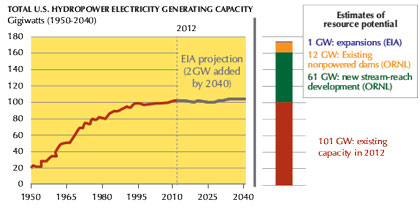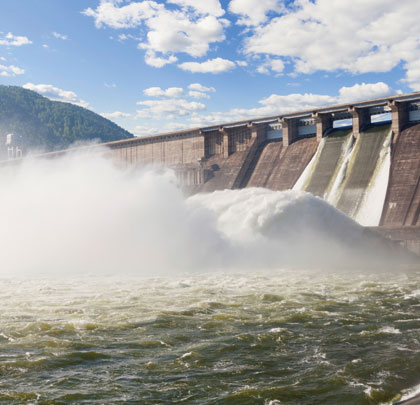A recent study conducted by Oak Ridge National Laboratory (ORNL) for the U.S. Department of Energy, the New Stream-reach Development Resource Assessment, finds that 61 gigawatts (GW) of hydroelectric power potential exists at waterways without existing dams or diversion facilities. This value excludes Alaska, Hawaii, and federally protected lands. ORNL’s hydropower resource estimates contrast with the 2 GW of additional hydropower capacity projected to be added through 2040 in EIA’s latest Annual Energy Outlook (AEO2014) Reference case. The difference in the two sets of numbers represents the significant gap between technical potential on the one hand and economic and operational potential on the other hand.
ORNL’s assessment used topographical, hydropower, hydrologic, and environmental datasets to assess the energy density at stream reaches (segments), while spatially linking to each stream’s respective ecological, social, cultural, policy, and legal constraints. The report quantified the technical resource capacity available at more than three million U.S. streams, qualifying its findings by saying “the methodology alone does not produce estimates of generation, cost, or potential impacts of sufficient accuracy to determine project-specific feasibility or to justify investments.”

Capacity values prior to 1989 are estimates. Existing capacity includes conventional hydroelectric and pumped storage. New stream-reach developments are stream segments without an existing dam. Expansions add power to existing dams. Some expansions are included in the Annual Energy Outlook 2014 projections (source: U.S. Energy Information Administration, EIA-860, and the Oak Ridge National Laboratory).
WHERE TO FIND NEW HYDRO POTENTIAL
Hydro resource studies typically estimate potential hydropower capacity by resource class: undeveloped sites without dams (new stream reach); existing dams without hydroelectric facilities, or nonpowered dams (NPDs); and existing hydroelectric facilities with potential for additional generating capacity, all included in the chart above. In addition to its current study of undeveloped sites, in 2012 ORNL completed a DOE-sponsored assessment of NPDs.
In that report, ORNL estimated that nonpowered dams could contribute as much as 12 GW of additional hydroelectric capacity. In addition, EIA’s AEO2014 also considers 1.4 GW of potential from the third resource class—expansion of existing hydroelectric facilities.

THE SEARCH IS ON FOR NEW SITES
Although resource potential quantifies maximum feasible capacity additions, EIA’s AEO2014 Reference case also considers market and policy hurdles that can limit actual development of a new hydroelectric power plant. These include economic factors, performance characteristics, federal regulations, electricity demand, and the cost of competing sources for new generation. Because hydropower is a mature technology, most of the technically and economically superior sites have already been developed.
NEW TECHNOLOGIES AWAIT
Current EIA projections do not reflect the recently released data from ORNL. However, the resource assessments for the AEO2014 Reference case do account for new stream-reach development and nonpowered dams potential and overlap between the two datasets is likely. Even though current EIA projections suggest that much of the undeveloped hydro resources may not be economic in the near- or mid-term, the latest ORNL report provides new information to assess the technical potential of hydropower and improve the understanding of resources that can take advantage of new technologies such as in-stream turbines. ■
[divider]
About the Authors
Michelle Bowman and Christopher Namovicz are analysts at the U.S. Energy Information Administration of the Department of Energy. To read a copy of the EIA’s Annual Energy Outlook 2014, visit www.eia.gov.
MODERN PUMPING TODAY, August 2014
Did you enjoy this article?
Subscribe to the FREE Digital Edition of Modern Pumping Today Magazine!


